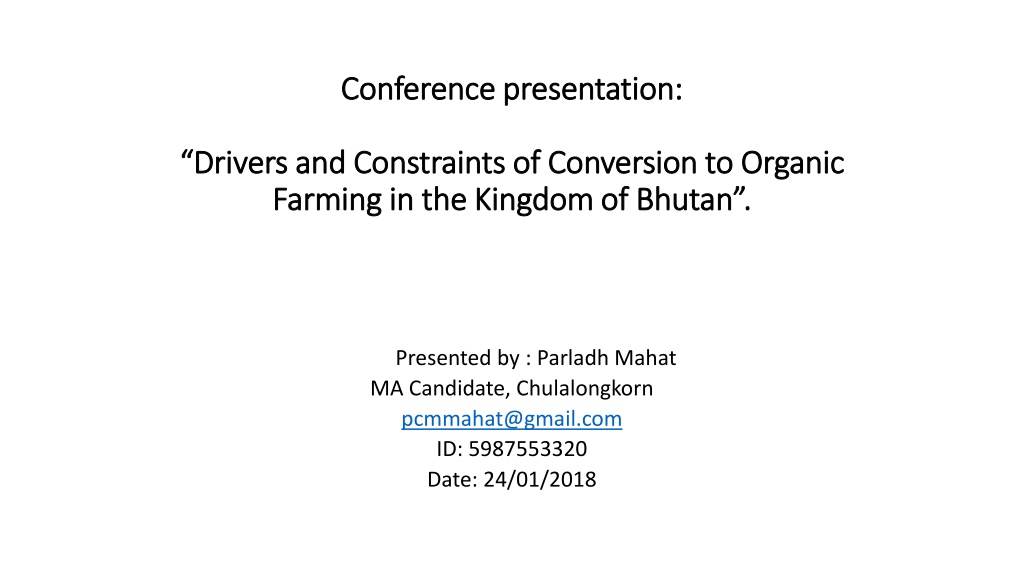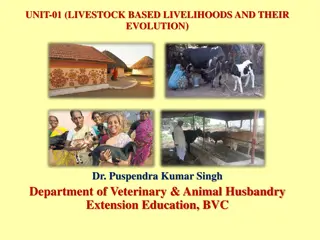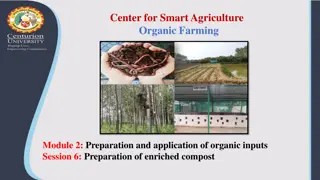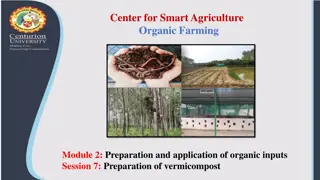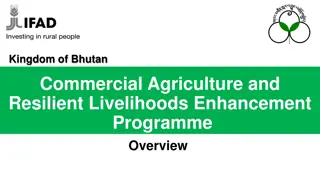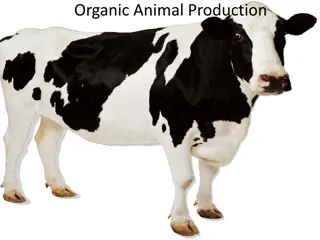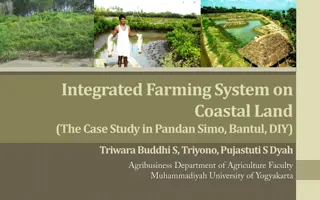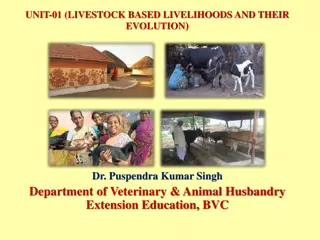Exploring Drivers and Constraints of Conversion to Organic Farming in Bhutan
Population in Bhutan heavily relies on agriculture, but the transition to organic farming has been slow despite the desire to reduce chemical use. This presentation investigates the current state of organic farming, identifies key factors affecting conversion, and offers policy recommendations to promote organic farming in the country.
Download Presentation

Please find below an Image/Link to download the presentation.
The content on the website is provided AS IS for your information and personal use only. It may not be sold, licensed, or shared on other websites without obtaining consent from the author. Download presentation by click this link. If you encounter any issues during the download, it is possible that the publisher has removed the file from their server.
E N D
Presentation Transcript
Conference presentation: Conference presentation: Drivers and Constraints of Conversion to Organic Drivers and Constraints of Conversion to Organic Farming in the Kingdom of Bhutan . Farming in the Kingdom of Bhutan . Presented by : Parladh Mahat MA Candidate, Chulalongkorn pcmmahat@gmail.com ID: 5987553320 Date: 24/01/2018
Outline of the presentation Outline of the presentation Introduction Research questions Objectives of study Study area Research methodology Results & Discussion Recommendation Conclusion Reference
Introduction Population depends on agriculture (56.6%) (NSB, 2016). Agriculture largely traditional in nature, small land holding (average 0.8 hectares),low productions & inputs (Tobgay, S.O.N.A.M. (2005), animal and human power Practices open burning . We use chemicals (though limited) Want to go organic reduce use of chemicals, improve health & income Significance of study Despite policy & acts, growth of OA is very gradual (total OA-13,144 hectares (6315 wild collection, 6829 agriculture area) with 2680 producers (Willer, H., & Lernoud, J. (2016). Despite importance limited study in developing countries (factors differs- market/subsidies/premium price/willingness to pay) Farmers reluctant to take up OF pests, weeds & disease issues, market, labor shortages & others
Research questions Research questions What is the current state of organic farming in Bhutan? What are the main drivers and constraints in conversion to organic farming? What are the appropriate measures to promote organic farming in Bhutan?
Objectives of the study Objectives of the study To explore the situation of the farming in the country and status of organic farming in Bhutan To investigate the drivers and constraints in conversion to organic farming by the farmers of Gasa district To provide the policy recommendation to government or relevant agency to promote organic farming in Bhutan
Study Area Study Area
Research Methodology Research Methodology Data collection Methods Target Survey Questionnaire Farmers Expert interview Agriculture experts ( 3 government officers, 4 local government officials & 2 Organic group members) All stakeholders ( farmers & officials) Field survey (observation) The purposive sampling technique (total household sampling) has been chosen because of the small size of the households in the study area
Data analysis Data analysis Data Methods SPSS Descriptive Statistic (mean & STD) Ranked Ordered of Importance by farmers Grouping or categorization of factors Prioritization of factors by farmers Descriptive analysis tools ( figures/ graphs & quotations) Survey Questionnaire (pry data) Expert interview Mean value Categorization >4 Most important Important Least important 3.5-4 <3.5
Result Result- -1 Personal information 1 Personal information Gender Formal study Age- Farmers relatively young (McCann,1990) Women empowerment- decision making power & division of labor Male Female 30.82% 69.18% Age category Education- Farmers were educated (Rogers, 1983 & Burton et al., 2003) 10.27% Economically active & social trends (rural migration & labor shortages) 13.70% 76.03% 31-59 18-30 >60 Encouraging result- majority of farmers illiterate Education Insignificant influence of education 0.68 78.08% 2.05% 13.70% 3.43% Illiterate NFE Primary High School Degree
Result 2- Perceptions of farmers Yes No 146 (100 %) 119 (81.51%) (18.49%) Farmers perceptions Familiar with organic farming Familiar with National Organic Policy Don t know 0 0 0 0 0 0 27 Continue farming organically Promote organic farming 145 1 0 0 1 (99.31%) 145 (99.31%) Very important 136 (93.15%) (0.69%) 0 0 Important 10 (6.85%) (0.69%) Not important 0 0 Importance of organic farming Years < 1 years 0 0 1-5years 17 (11.64%) 6-10 17 (11.64%) >10 112 76.72% Started organic farming
Result 3- Drivers Previous study: 1. South Africa by Niemeyer, K., & Lombard, J (2003) Environmental conservation enhance Environmental conservation enhance 5 Provides employment opportunities Provide employment opportunities 2. Health-several studies (Veisi, H et al., 2017 in Iran & Pornpratansombat et al., 2011 in T/land Protect biodiversity 4.123 3.938 4 3.445 3 Help improve soil fertility Contribute to education Contributes to education Help improve soil fertility 4.171 2 3.329 3. Niemeyer, K., & Lombard, J (2003) & by Mzoughi, N (2011) in France 1 0 3.849 3.863 Enhances food quality Help reduce environmental pollution 4. Increase- North Nicaragua by Bacon, C. (2005) & in Uganda by Gibbon et al., (2007) 5. In consistent with study by GOI, 2004 & Setboonsarng, S. 2006 4.157 Improve personal health & family health 3.808 Improve personal health & family health Reduce external input costs 4.014 3.616 Help increase income Provision of subsidies Help increase income 6. Contradicts with literature ( Devi,R., Kumar et al., 2017)
Results 4 Results 4- -Constraints Constraints Decrease in productivity Decrease in productivity 5 Ineffective weeds control Lack of education of farmers & organic research Ineffective weeds control 4 3.192 3 4.404 3.555 2 Ineffective transportation facilities Ineffective transportation facilities Ineffective pest & disease control Ineffective pests & disease control 3.719 4.473 1 0 4.144 3.438 Access to organic seeds Increase labor requirement Increase labor requirement 2.527 3.281 Access to credit facilities Costly certification & inspections Costly certification and inspections 3.657 Lack of access to market Lack of access to market
Recommendations Recommendations 1. Research and development Less research & invest more on research culture Research priority- pests & disease control, improving soil fertility, new crop varieties & plant protection techniques, bio-fertilizers & bio-pesticides Participatory approach-involve all relevant stakeholders rather than working in isolation 2. Information and awareness Adequate information on several benefits of OF (env/social & economic) Media campaigns, workshops, publications, books Initiate more organic community & trail activity 3. Capacity building For management of pests, weeds and disease control training, workshop & study tour Focus on product diversifications, nutrient management, plant protections and preparation of bio-pesticides, bio-fertilizers, preparation of mulch and seed selections Provide hands on training & workshop on organic kitchen gardening, community living and natural building & agriculture exchange programs
Recommendations Recommendations 4. Market intensification Limited market in developing countries (only centenary farmers market) Improve through better transports, formation of farmer s groups and cooperatives and media campaigns, infrastructure development with access to market information (IT development) radio/mobile application & television Direct market linkages to institutions, restaurants & high end hotels 5. Policy support Access to credit (loan) Interest free credit & crop insurance schemes Support for GRF land lease ( Make procedures farmers friendly) Decentralize approving authority to district administration Include OA in educational program, strengthen SAP & inter school agriculture fairs 6. Formation of groups and cooperatives Provide equal participation & sharing of responsibility Collective marketing, reduce certification costs & promote crops, vegetables & fruits
Conclusion Conclusion Agriculture development is hindered by rugged terrain, steep slopes and low farm mechanization Changing from small scale subsistence based to market oriented productions OA is graining importance due to health & environment concerns, increasing consumers & producers awareness & growing demand. Farmers opinion in general is very positive & very strong and aspires to continue farming organically Future development of OA would depend on policy support to reduce constraints faced by growers and take advance of opportunities.
THANK YOU VERY MUCH !! THANK YOU VERY MUCH !! Q/A Q/A
Reference Reference Agricultural Statistic, 2014: Department of Agriculture, MOAF, Thimphu. Appachanda, T. (2014). Zero-cost Organic Certification System: A Beginning. Azadi, H., Schoonbeek, S., Mahmoudi, H., Derudder, B., De Maeyer, P., & Witlox, F. (2011). Organic agriculture and sustainable food production system: main potentials. Agriculture, Ecosystems & Environment, 144(1), 92-94. Bacon, C. (2005). Confronting the Coffee Crisis: Can Fair Trade, Organic and Specialty Coffee Reduce Small-Scale Farmer Vulnerability in Northern Nicaragua? World Development 33(3): 497-511. Bakewell-Stone, P., Lieblein, G., & Francis, C. (2008). Potentials for organic agriculture to sustain livelihoods in Tanzania. International Journal of Agricultural Sustainability, 6(1), 22- 36. Beuchelt, T. D., & Zeller, M. (2013). The role of cooperative business models for the success of smallholder coffee certification in Nicaragua: A comparison of conventional, organic and Organic-Fairtrade certified cooperatives. Renewable Agriculture and Food Systems, 28(03), 195-211. Bhutan Organic Certification System (BOCS).2013. Bhutan Agriculture and Food regulatory Authority (BAFRA), Ministry of Agriculture and Forests, Royal Govt. of Bhutan
Reference Reference Bond, W. and Grundy, A. C. (2001), Non-chemical weed management in organic farming systems. Weed Research, 41: 383 405. doi:10.1046/j.1365- 3180.2001.00246.x Choden, Kunzang (2008) Chilli and Cheese: Food and Society in Bhutan. Thimphu: White Lotus Press Connor, D. J. (2008). Organic agriculture cannot feed the world. Field Crops Research, 106(2), 187-190. Connor, D. J. (2013). Organically grown crops do not a cropping system make and nor can organic agriculture nearly feed the world. Field Crops Research, 144, 145-147. Dorji, K. D. (2008, May). Agriculture and soil fertility management in Bhutan: An overview. In Country paper presented in the meeting of Asia-Pacific Net on Integrated Plant Nutrient Management & International Workshop on Sustainable Nutrient Management: Technology & Policy. (Increase in pesticides in the country) Das, K. (2007). Towards a smoother transition to organic farming. Economic and Political Weekly, 2243-2245.
Reference Reference Devi, R., Kumar, A., & Deboch, B. (2007). Organic farming and sustainable development in Ethiopia. Scientific Research and Essays, 2(6), 199-203 Duba, S., Ghimiray, M., & Gurung, T. R. (2008). Promoting organic farming in Bhutan: A review of policy, implementation and constraints. Council for RNR Research of Bhutan, Ministry of Agriculture, Thimphu, Bhutan Duram, L. A. (2000). Agents' perceptions of structure: How illinois organic farmers view political, economic, social, and ecological factors. Agriculture and Human Values, 17(1), 35-48. Retrieved from https://search.proquest.com/docview/214186052?accountid=15637 FAO (2015), Country Fact Sheet on Food and Agriculture Policy Trends, FAPDA, Ghana Ferruh Isin, Tayfun Cukur and Goksel Armagan (2007). Factors Affecting the Adoption of the Organic Dried Fig Agriculture System in Turkey. Journal of Applied Sciences, 7: 748-754. Gurung T (2008) Organic farming in Bhutan. In: Rennie F, Mason R (eds) Bhutan: Ways of Knowing. Information Age Publishing Inc., USA, 205-210 Gibbon, P., & Bolwig, S. (2007). The economics of certified organic farming in tropical Africa: A preliminary assessment (No. 2007: 3). DIIS working paper.
Reference Reference GOI (2004), Report of the Committee on Revitalization of Sugar Industry, Ministry of Food, Consumer Affairs and Publication Distribution, Government of India, New Delhi. G mez, M. I., Barrett, C. B., Buck, L. E., De Groote, H., Ferris, S., Gao, H. O., ... & Reardon, T. (2011). Research principles for developing country food value chains. Science, 332(6034), 1154-1155. Giovannucci, D. (2005). Organic agriculture and poverty reduction in Asia: China and India focus Ghazaryan, A. (2016). Collective action as a way to develop Organic Farming in Armenia. International Journal of Business and Economic Development (IJBED), 4(2) GNHC (2013) Eleventh Five Year Plan, 2013-2018. In:http://www.gnhc.gov.bt/wpcontent/uploads/2011/04/Eleventh-Five-Year-Plan.pdf. Gyeltshen, Jamba (2008) Student Handbook for Agrochemicals. Agro-chemicals and Weed Science, College of Natural Resource, Royal University of Bhutan. Retrieved from cms.cnr.edu.bt.
Reference Reference Hall, A., & Mogyorody, V. (2007). Organic farming, gender, and the labor process. Rural Sociology, 72(2), 289-316. Jansen, K. (2000). Labour, livelihoods and the quality of life in organic agriculture in Europe. Biological agriculture & horticulture, 17(3), 247-278. Karma, G. M., & Ghimiray, M. (2006). Rainfed lowland rice cultivation in Bhutan: a survey report. Bhu J RNR, 2, 93-114. Karki, L., Schleenbecker, R., & Hamm, U. (2012). Factors influencing a conversion to organic farming in Nepalese tea farms. Journal of Agriculture and Rural Development in the Tropics and Subtropics (JARTS), 112(2), 113-123. Kisaka-Lwayo, M. (2007, August). A discriminant analysis of factors associated with the adoption of certified organic farming by smallholder farmers in Kwazulu-Natal, South Africa. In Institution/Association: African Association of Agricultural Economists (AAAE)> 2007 Second International Conference.
Status of Organic farming Status of Organic farming Agriculture largely traditional in nature & farming practices similar to OF practices The organic agriculture growth after formal launch of NOP, 2007 and NFOFB, 2007 (Duba et al. 2008). Growth is very gradual and Bhutan has less than 10% of the land underorganic agricultural productions (Neuhoff et al. 2014) No official records & statistic prior to 2012 for comparison. By 2013 OF has spread in all twenty district (Tshomo, 2014 as stated by Tashi, S. (2015). Total organic land-13,144 hectares as of 2014 (6315 hectares of wild collections and 6829 hectares of agricultural land) with a total of 2680 organic growers & its world share of organic agricultural land is just 1.3 percent (Willer, H., & Lernoud, J. (2016). Majority of land considered organic by-default (Pretty et al., 2006) & easier for the country to go fully organic (Duba, S., Ghimiray, M., & Gurung, T. R. (2008). OA program extended to green schools across country & organic community & pilot activities are initiated.
